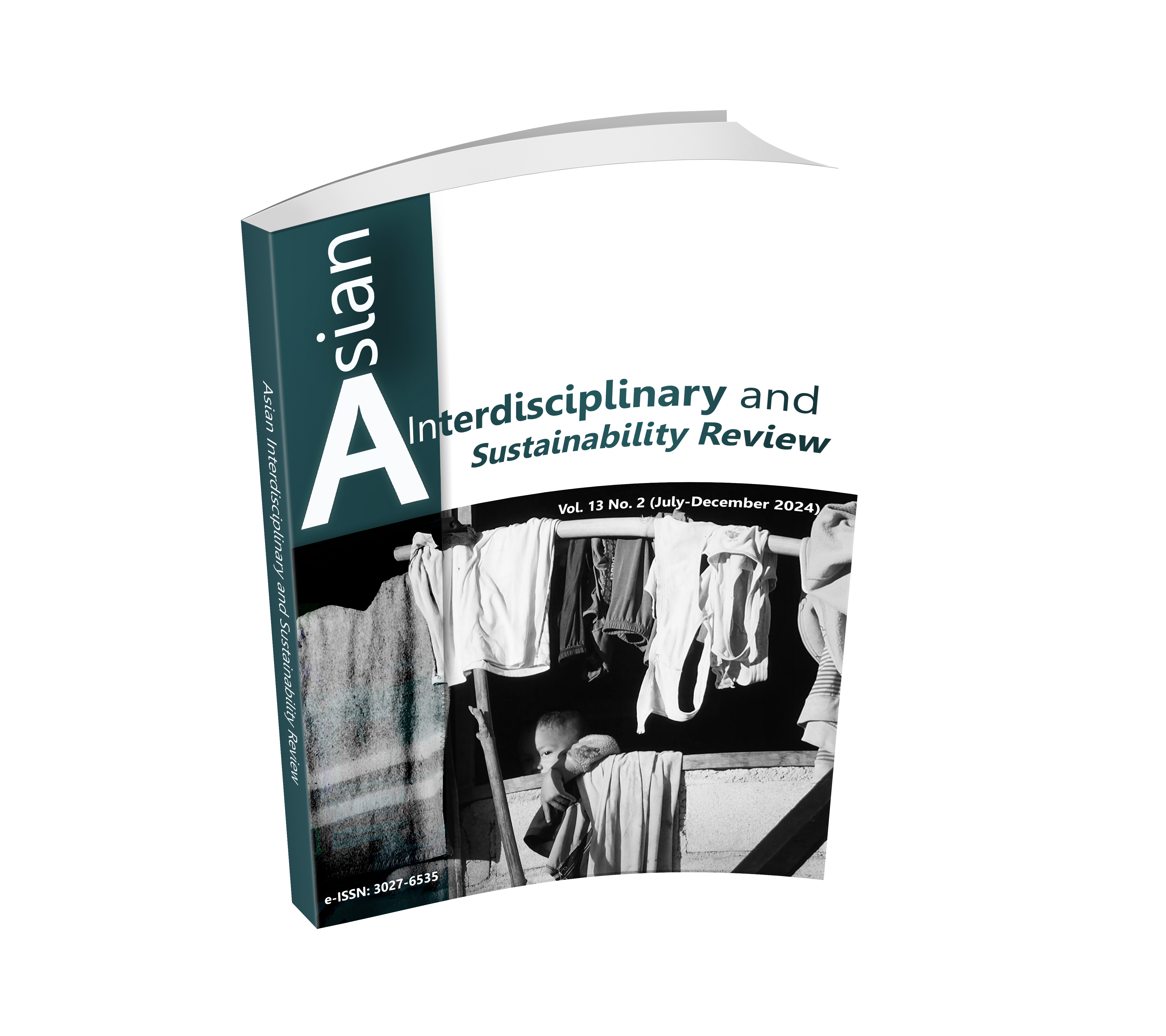GENDERED MOBILITY AND SUSTAINABLE URBAN TRANSPORT: WOMEN'S EXPERIENCES ON MUMBAI'S SUBURBAN RAILWAY
DOI:
https://doi.org/10.14456/aisr.2024.21Keywords:
Public Transport, Transit Captivity, Megacity, Suburban Trains, IndiaAbstract
In the urban landscape of Mumbai, women commuters navigate a complex interplay of gender and mobility within their daily commutes on the suburban railway system. Balancing diverse domestic and professional roles, their experiences and perceptions of mobility are shaped by societal structures and safety concerns, often resulting in transit captivity. This study adopts a qualitative approach grounded in feminist epistemology, conducting in-depth semi-structured ethnographic interviews with both daily and occasional women travellers on Mumbai's local trains. Through a gendered lens and thematic analysis, this research uncovers the varied mental models and socio-cultural influences that shape women's mobility decisions, revealing their travel experiences, preferences, and constraints. The findings highlight the layered complexities of women's mobility needs and the shortcomings of current urban transport systems in addressing these needs, particularly regarding safety, accessibility, and inclusivity. This study contributes to the literature on urban mobility, gender equity, and sustainable transportation by integrating a theoretical framework that centres women's experiences. It advocates for a more holistic approach to urban planning in densely populated and developing contexts, emphasizing the need for inclusive transport policies that consider the diverse needs of all urban residents.
Downloads
References
Arundhathi. (2024). Gender-based spatial segregation: ladies’ compartments in the Mumbai local trains. Gender, Place & Culture, 31(2), 133-153.
Bamberger, M., Lebo, J., Gwilliam, K., & Gannon, C. (1999). Gender and Transport: A Rationale for Action (Working Paper No.4). USA.: World Bank.
Bardzell, S. (2018). Utopias of Participation: Feminism, Design, and the Futures. ACM Transactions on Computer-Human Interaction, 25(1), 1-24.
Blumer, H. (1969). Symbolic Interactionism: Perspective and Method. California: University of California Press.
Butcher, M., & Maclean, K. (2018). Gendering the city: The lived experience of transforming cities, urban cultures, and spaces of belonging. Gender, Place & Culture, 25(5), 686-694.
Butler, J. (1990). Gender Trouble: Feminism and the Subversion of Identity. New York: Routledge.
Crenshaw, K. (1989). Demarginalizing the Intersection of Race and Sex: A Black Feminist Critique of Antidiscrimination Doctrine, Feminist Theory and Antiracist Politics. University of Chicago Legal Forum, (1), Article 8.
Cresswell, T. (2014). Friction. In P. Adey, D. Bissell, K. Hannam, P. Merriman, & M. Sheller. (eds.). The Routledge Handbook of Mobilities (pp. 1-9). London: Routledge.
Cresswell, T., & Uteng, P. (2008). Gendered Mobilities: Towards a Holistic Understanding. In T. Uteng. (ed.). Gendered Mobilities (pp. 1-12). London: Routledge.
Dhaundiyal, D., & Sharma, N. (2020). Ladies’ Special: A Mixed Methods Study of Female Commuters in Mumbai Local Trains for Requirement Capture. A paper presented at the IIID Mobility & Transport Forum 2020, Indian Institute of Technology Bombay, India.
Erickson, J. (1977). An analysis of journey-to-work for women. Social Problems, 24(4), 428-435.
Fernando, P. (1999). Balancing the load: gender issues in rural transport. A paper presented at the International Forum for Rural Transport and Development, London, United Kingdom.
Herman-Kinney, N., & Verschaeve, J. (2003). Methods of Symbolic Interactionism. In L. Reynolds, & N. Herman-Kinney. (eds.). Handbook of Symbolic Interactionism (pp. 213-252). California: AltaMira Press.
Hjorthol, R. (2001). Gendered Aspects of Time Related to Everyday Journeys. Acta Sociologica, 44(1), 37-49.
Lefebvre, H. (1968). Le Droit à La Ville. Paris: Anthropos.
Levy, C. (1992). The Importance of Gender in Planning Urban Transport. London: Routledge.
Loukaitou-Sideris, A. (2020). A Gendered View of Mobility and Transport. In I. de Madariaga, & M. Neuman. (eds.). Engendering Cities: Designing Sustainable Urban Spaces for All (pp. 1-19). New York: Routledge.
Lune, H., & Berg, B. (2018). Qualitative Research Methods for the Social Sciences. London: Pearson Higher Education.
Mahambare, V., & Dhanaraj, S. (2022). Women's challenging commutes in southern India: A case of the metropolitan region of Chennai. Cities, 127, 103738.
Massey, D. (1994). Space, Place, and Gender. Minnesota: University of Minnesota Press.
Parikh, A. (2018). Politics of presence: Women’s safety and respectability at night in Mumbai, India. Gender, Place & Culture, 25(5), 695-710.
Pas, E. (1984). The Effect of Selected Sociodemographic Characteristics on Daily Travel-Activity Behavior. Environment and Planning A: Economy and Space, 16(5), 571-581.
Peters, D. (2001). Gender and Transport in Less Developed Countries: A Background Paper in Preparation for CSD-9. Retrieved from www.ssatp.org/sites/ssatp/files/publications/HTML/Gender-RG/Source%20%20documents/Issue%20and%20Strategy%20Papers/G&T%20Rationale/ISGT4%20Gender%20and%20transport%20in%20LDCs%20UNED%2001.pdf.
Pfeiffer, S. (2021). Mind the gap: Gender dimensions in urban mobility - A case study investigating sustainable urban mobility of female public transport users in Delhi, India. Retrieved from https://lup.lub.lu.se/student-papers/search/publication/9053053.
Shaban, A., & Sattar, S. (2023). Mobility and transport infrastructure in Mumbai Metropolitan Region: growth, exclusion and modal choices. Urban, Planning and Transport Research, 11(1), 2212745.
Sheller, M. (2018). Mobility Justice: The Politics of Movement in an Age of Extremes. London: Verso.
Spain, D. (1992). Gendered Spaces. Carolina: The University of North Carolina Press.
Tara, S. (2011). Private Space in Public Transport: Locating Gender in the Delhi Metro. Economic and Political Weekly, 46(51), 71-74.
Thomas, W., & Thomas, D. (1928). The Child in America: Behavior Problems and Programs. Virginia: University of Virginia.
Turner, J., & Fouracre, P. (1995). Women and Transport in Developing Countries. Transport Reviews, 15(1), 77-96.
UN Women. (2019). Safe Cities and Safe Public Spaces for Women and Girls Global Flagship Initiative: International Compendium of Practices. Retrieved from www.unwomen.org/en/digital-library/publications/2019/01/safe-cities-and-safe-public-spaces-international-compendium-of-practices.
Urry, J. (2004). Connections. Environment and Planning D: Society and Space, 22(1), 27-37.
Uteng, T., Singh, Y., & Lam, T. (2019). Safety and daily mobilities of urban women—Methodolgies to confront the policy of “invisibility”. In Measuring Transport Equity (pp. 187-202). Amsterdam: Elsevier.
Verma, M., Rodeja, N., Manoj, M., & Verma, A. (2020). Young Women’s Perception of Safety in Public Buses: A Study of Two Indian Cities (Ahmedabad and Bangalore). Transportation Research Procedia, 48, 3254-3263.

Downloads
Published
How to Cite
Issue
Section
License
Copyright (c) 2024 Authors

This work is licensed under a Creative Commons Attribution-NonCommercial-NoDerivatives 4.0 International License.











.png)


